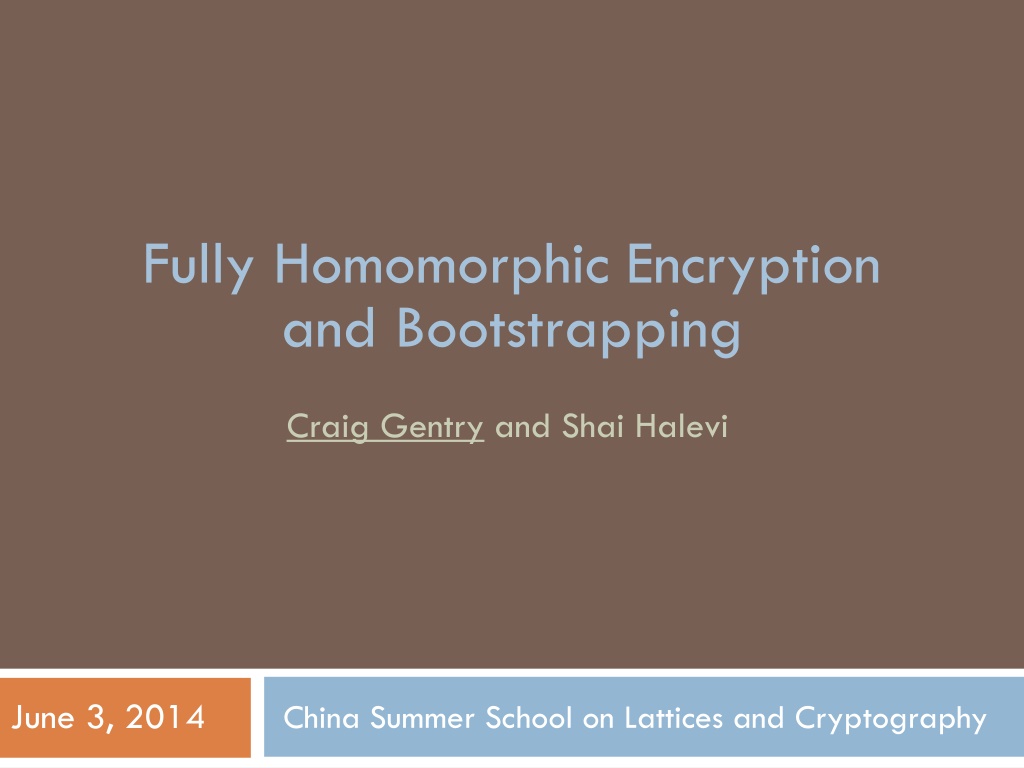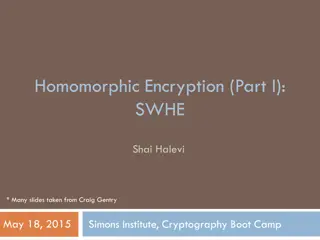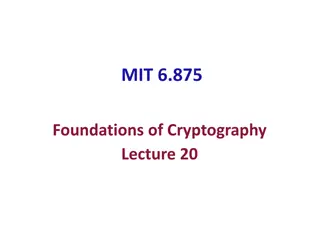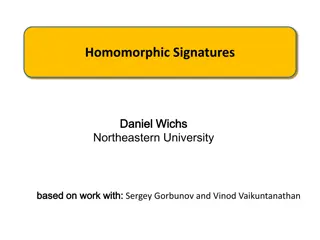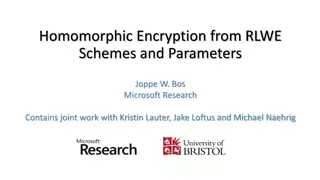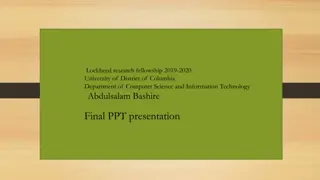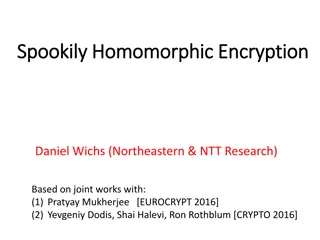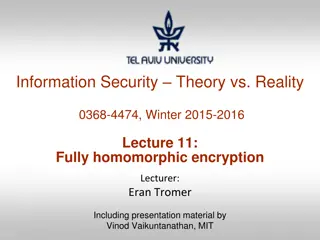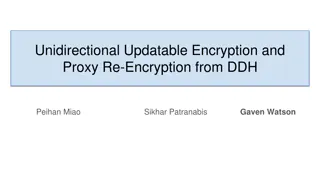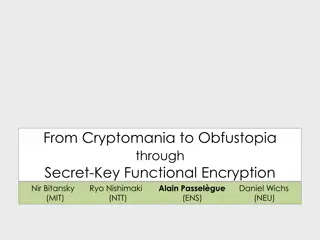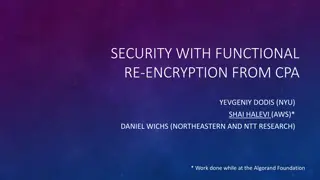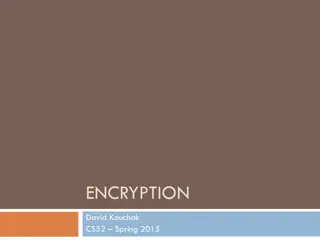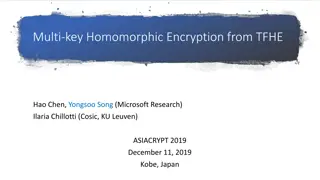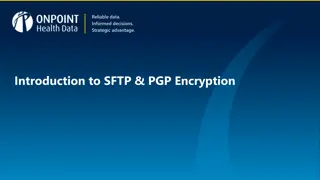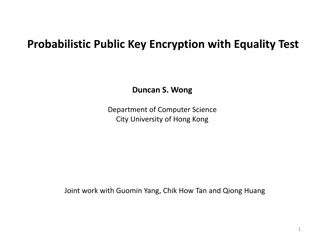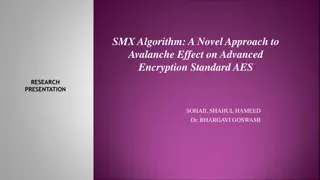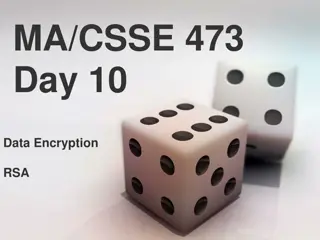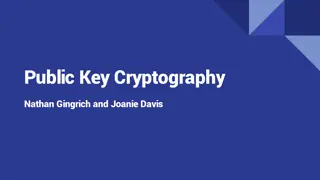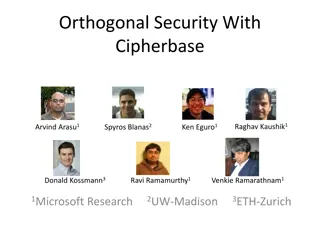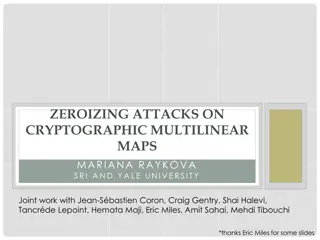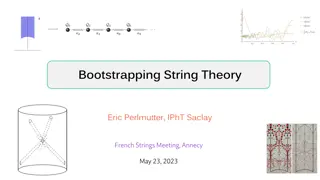Bootstrapping in Fully Homomorphic Encryption
Fully Homomorphic Encryption (FHE) allows evaluation of unbounded-depth circuits without being limited by specific parameters. Bootstrapping is a critical technique to achieve full homomorphism by refreshing ciphertexts, enabling decryption functionalities within the encryption scheme. This process enhances the capacity to evaluate complex circuits while mitigating noise in evaluated ciphertexts. Philosophy meets cryptography as we explore the implications of self-referential encrypted computation and the decryption capabilities of homomorphic encryption schemes. Dive into the intricate world where mathematics, computer science, and encryption intersect to push the boundaries of secure computation.
Download Presentation

Please find below an Image/Link to download the presentation.
The content on the website is provided AS IS for your information and personal use only. It may not be sold, licensed, or shared on other websites without obtaining consent from the author. Download presentation by click this link. If you encounter any issues during the download, it is possible that the publisher has removed the file from their server.
E N D
Presentation Transcript
Fully Homomorphic Encryption and Bootstrapping Craig Gentry and Shai Halevi June 3, 2014 China Summer School on Lattices and Cryptography
Fully Homomorphic Encryption (FHE) A FHE scheme can evaluate unbounded depth circuits Not limited by bound specified at Setup Parameters (like size of ciphertext) do not depend on evaluated depth So far, GSW scheme can evaluate only depth logN+1q How do we make it fully homomorphic? Bootstrapping: A way to get FHE
Self-Referential Encrypted Computation
A Digression into Philosophy Can the human mind understand itself? Or, as a mind becomes more complex, does the task of understanding also become more complex, so that self- understanding it always just out of reach? Self-reference often causes problems, even in mathematics and CS Godel s incompleteness theorem Turing s Halting Problem
Philosophy Meets Cryptography Can a homomorphic encryption scheme decrypt itself? We can try to plug the decryption function Dec( , ) into Eval. If we run Evalpk(Dec( , ), c1, , ct), does it work? Suppose our HE scheme can Eval depth-d circuits: Is it always true that HE s Dec function has depth > d? Is Dec( , ) always just beyond the Eval capacity of the HE scheme? Bootstrapping = the process of running Eval on Dec( , ).
Bootstrapping: Assuming we can do it, why is it useful?
Bootstrapping: Refreshing a Ciphertext So far, we can evaluate bounded-depth circuits f: f 1 2 f( 1, 2 , , t) t We have a noisy evaluated ciphertext y We want to get another y with less noise Bootstrapping refreshes ciphertexts, using the encrypted secret key.
Bootstrapping: Refreshing a Ciphertext For ciphertext c, consider the function Dc( ) = Dec( ,c) Suppose we can Eval depth d, but Dc( ) has depth d-1. Include in the public key also Encpk(sk) y c Dc sk1 sk1 sk2 sk2 Dc(sk) = Dec(sk,c) = y c' = skn skn
Bootstrapping Theorem (Informal) Suppose is a HE scheme that can evaluate arithmetic circuits of depth d whose decryption algorithm is a circuit of depth d-1 Call a bootstrappable HE scheme Thm: From a bootstrappable somewhat homomorphic scheme, we can construct a fully homomorphic scheme. Technique: Refresh noisy ciphertexts by evaluating the decryption circuit homomorphically
Lets Look at the Decryption Circuit Typically in LWE-based encryption schemes, if c encrypts under secret key vector s, then: where [ ]q denotes reduction modulo q into the range (-q/2,q/2].
Decryption in GSW GSW fits the template: ( )
How Complex Is Decryption? If q is polynomial (in the security parameter ) then decryption is in NC1 (log-depth circuits). But wait isn t q really large? q depends on the Eval capacity of the scheme Ideally, we would like the complexity of Dec to be independent of the Eval capacity.
Modulus Reduction Magic Trick Suppose c encrypts that is, = [[<c,t>]q]2. Let s pick p<q and set c* = (p/q) c, rounded. Crazy idea: Maybe it is true that: c* encrypts : = [[<c*,t>]p]2 (new inner modulus). Surprisingly, this works! After modulus reduction (and dimension reduction), the size of the ciphertext is independent of the complexity of the function that was evaluated!!
Modulus Reduction Magic Trick, Details Scaling lemma: Let p<q be odd moduli. Suppose = [[<c,t>]q]2 and |[<c,t>]q| < q/2 - (q/p) l1(t). Set c = (p/q)c and set c to be the integer vector closest to c such that c = c mod 2. Then = [[<c ,t>]p]2. Annotated Proof: 1. For some k, [<c,t>]q = <c,t> - kq. 2. (p/q)|[<c,t>]q| = <c ,t> - kp. 3. |<c -c ,t>| < l1(t). 4. Thus, |<c ,t>-kp|< (p/q) |[<c,t>]q| + l1(t) < p/2. 5. So, [<c ,t>]p = <c ,t> kp. 6. Since c = c mod 2 and p = q mod 2, we get [<c ,t>]p]2 = [<c,t>]q]2. 1. Imagine <c,t> is close to kq. 2. Then <c ,t> is close to kp. 3. <c ,t> also close to kp if s small.
Modulus Reduction Magic Trick, Notes [ACPS 2009] proved LWE hard even if t is small: t chosen from the same distribution as the noise e With coefficients of size poly in the security parameter. For t of polynomial size, we can modulus reduce to a modulus p of polynomial size, before bootstrapping. Bottom Line: After some processing, decryption for LWE-based encryption schemes (like GSW) is in NC1. Complexity of Dec is independent of Eval capacity.
Evaluating NC1 Circuits in GSW Na ve way: Just to log levels of NAND Each level multiplies noise by polynomial factor. Log levels multiplies noise by quasi-polynomial factor. Bad consequence = weak security: Based on LWE for quasi-polynomial approximation factors.
Part II: Bootstrapping and Barrington s Theorem Focusing on Brakerski and Vaikuntanathan s method to bootstrap the Gentry-Sahai-Waters scheme
Better Way to Evaluate NC1 Circuits? Goal: Base security of FHE on LWE with poly factors. Evaluate NC1 circuits in a more noise-friendly way so that there is only polynomial noise blowup. Barrington s Theorem If f is computable by a d-depth Boolean circuit, then it is computable by a width-5 permutation branching program of length 4d. Corollary: every function in NC1 has a polynomial-length BP.
Width-5 Permutation Branching Programs BP for function f: Consists of labeled permutations in the permutation group S5 (which we represent as 5x5 permutation matrices) S5 is a non-abelian group: maybe ab ba. To evaluate BP (hence f) on input X: Map X to a subset SX of the matrices (using labels) Compute product of the matrices in SX Output 1 if the product is the identity matrix, 0 otherwise
Width-5 Permutation Branching Programs A1,0 A2,0 A3,0 A4,0 A5,0 A6,0 A7,0 A8,0 A9,0 A1,1 A2,1 A3,1 A4,1 A5,1 A6,1 A7,1 A8,1 A9,1 0 Each Ai,b is a 5x5 permutation matrix. This BP takes 4-bit inputs and has length 9
Width-5 Permutation Branching Programs A1,0 A2,0 A3,0 A4,0 A5,0 A6,0 A7,0 A8,0 A9,0 A1,1 A2,1 A3,1 A4,1 A5,1 A6,1 A7,1 A8,1 A9,1 0 1 Each Ai,b is a 5x5 permutation matrix. This BP takes 4-bit inputs and has length 9
Width-5 Permutation Branching Programs A1,0 A2,0 A3,0 A4,0 A5,0 A6,0 A7,0 A8,0 A9,0 A1,1 A2,1 A3,1 A4,1 A5,1 A6,1 A7,1 A8,1 A9,1 0 1 1 0 Each Ai,b is a 5x5 permutation matrix. This BP takes 4-bit inputs and has length 9 Multiply the chosen 9 matrices together If product is I, output 1. Otherwise, output 0.
Brakerski and Vaikuntanathans Insight Multiplications in GSW increase noise asymmetrically. Moreover, this asymmetry is useful. Can exploit it to evaluate permutation BPs with surprisingly little noise growth.
Warm Up: High Fan-in AND Gates Binary Tree approach: AND t ciphertexts using a (log t)- depth binary tree. Noise grows by (N+1)log t factor. Left-to-right approach: AND t ciphertexts by multiplying sequentially from left to right The i-th multiplication only adds Ci ei+1 to the error. Ci {0,1}NxN is the aggregate-so-far ei+1 is the (small) error of the (i+1)-th ciphertext. Noise grows by t(N+1) factor. Right-to-left approach: horrible!
Multiplying Permutation Matrices Given kxk permutation matrices encrypted entry-wise, multiplying them left-to-right is best. Multiplying in the (i+1)-th permutation matrix adds about k(N+1) times the error of fresh ciphertexts. Essential fact used in analysis: In a permutation matrix, only one entry per column is nonzero.
Lattice-Based FHE as Secure as PKE [BV14] Bottom line: GSW decryption can be computed homomorphically while increasing noise by a poly factor. FHE can be based on LWE with poly approx factors. The exponent can be made -close to that of current LWE- based PKE schemes.
Part IV: FHE from Non-Abelian Groups? A somewhat promising framework for FHE inspired by Barrington s Theorem
Goal: Totally Different Approach to FHE FHE without noise? Might also make (expensive) bootstrapping unnecessary How about FHE based on non-abelian groups? Might avoid linear algebra attacks for ring-based schemes Another chance to apply Barrington. Framework investigated by Nuida ePrint 2014/07: A Simple Framework for Noise-Free Construction of Fully Homomorphic Encryption from a Special Class of Non-commutative Groups
Perfect Group Pairs Groups (G, H) such that: H is a (proper, nontrivial) normal subgroup of G H = {ghg-1 : g G, h H} G and H are perfect groups Commutator subgroup [G,G] = <g1g2g1-1g2-1: g1,g2 G> G is perfect when G = [G,G]
Efficient Group Operations Randomization: Given a group (say, G) represented by some generators, output n random G- elements that generate the group.
Hardness Assumption Subgroup Decision Assumption (for perfect group pairs): Given n elements that generate either G or H, hard to distinguish which.
FHE Construction Public key: An encryption of 0: n elements that generate G An encryption of 1: n elements that generate H Secret key: Trapdoor to distinguish G from H (represented by generators). Encryption: Randomize the encryption of 0 or 1. AND gate: Given generators of groups K1, K2, output generators of the union of K1,K2. (Use union of generators.) OR gate: Given generators of groups K1,K2, output generators of intersection of K1,K2. (Use commutator.) G = [G,G], H = [H,H], H = [G,H].
Existence? Need perfect group pairs with hard distinguishing problem (and efficient operations and a trapdoor) Example of perfect group pair with easy dist. problem: Direct product: G = H K, where H and K are perfect
Failed Attempt Form of G elements Form of H elements Linear algebra attack: Encryptions of 0 in proper subspace Is there a patch? Can we use non-abelian groups without fatally embedding them in a ring? (representation theory)
Barrington and Non-Abelian Groups NC1 circuits to a product of permutations On each circuit wire w: 0 is represented by the identity permutation 1 is represented by some non-identity permutation w AND(w1,w2) = w1 w2 w1-1 w2-1 Equals ( 0 ) if either w1 or w2 is ( 0 ) Equals a non-identity permutation if the inputs are non- commuting non-identity permutations w1 and w2.
The Noise Problem Revisited Ciphertext noise grows exponentially with depth d. Hence log q and dimension of ciphertext matrices grow linearly with d. Want overhead to be independent of d. To only depend on the security parameter . Achievable! Via a technique called bootstrapping [Gentry 09].
